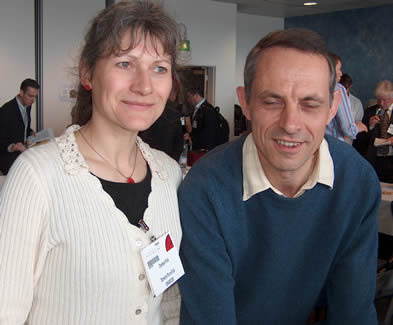|
The wines
of Domaine
Pierre Frick, Alsace
Chantal and Jean-Pierre Frick, 5 Rue de Baer, 68250
Pfaffenheim, France
Website : www.pierrefrick.com
E-mail : pierre.frick@wanadoo.fr
 Jean-Pierre
Frick (pictured right with his wife Chantale: unfortunately he has
his eyes closed!) is one of the Alsace pioneers in biodynamie: he
converted in 1981 after having already turned to organics in 1970.
Altogether he farms 12 hectares of vineyards, in several plots, a
third of which is rented. Wines are fermented solely with indigenous
yeasts and there is no acidification or chaptalization. Each year, a
couple of the cuvées are made without any sulfur dioxide additions. Jean-Pierre
Frick (pictured right with his wife Chantale: unfortunately he has
his eyes closed!) is one of the Alsace pioneers in biodynamie: he
converted in 1981 after having already turned to organics in 1970.
Altogether he farms 12 hectares of vineyards, in several plots, a
third of which is rented. Wines are fermented solely with indigenous
yeasts and there is no acidification or chaptalization. Each year, a
couple of the cuvées are made without any sulfur dioxide additions.
As
with many biodynamic growers, the vineyard receives much of the focus.
With the shift to biodynamics in 1981, Frick began working the soil in
the winter and leaving the grass to grow in the vine growing season,
with a couple of passes from the mower to keep it under control. Since
1999 they’ve further modified their vineyard interventions: no
rotary tools are used any longer; just simple tractor-drawn ones to
preserve the soil structure.
Various
biodynamic preparations are applied according to the cosmic rhythms of
the Maria Thun calendar (this is the guide that most biodynamic
growers use to help them do things at the right time, from vineyard
work to racking to bottling). 10–15 tons/hectare of compost are
spread every five years or so to maintain soil fertility. Biodynamic
treatments are supplemented with other sprays, where these are
essential. Bordeaux mixture is used to combat mildew, but less than 1
kg/copper per hectare each year is applied. Sulfur is used to combat
oidium. Bacillus thuriguensis,
a bacterium, is used to protect some of the more vulnerable varieties
from leaf-roller moths, where the typical biodynamic preparations
would otherwise not be effective.
Harvesting
is by hand, which is expensive, but is important for ‘the social
side experienced during harvest and the search of quality through
grape selection’. In the winery whole-bunch pressing is used, the
juice is left to settle overnight, and then 98% of the juice is taken
off for fermentation. Since 1998 there has been no chaptalization
here. Old oak casks, averaging 3000 litres capacity, are used for
maturation. The wines have only a small sulfur addition (this is the
only addition made here), with a couple of cuvées each year having no
added sulfur at all. The results are certainly interesting, and of a
high quality, but the slightly oxidative style of the Vorburg didn’t
work for me, and the Sylvaner is a bit of an acquired taste. I liked
the two Steinert wines.
Riesling
Grand Cru Vorburg 2003
Open nutty nose leads to a palate that is broad, nutty and
slightly oxidative. It’s an interesting wine that’s quite rich and
long. Very good+ 88/100
Riesling
Grand Cru Steinert 2003
Nutty, honeyed nose is quite fresh with lemony fruit. The palate
is fresh and bright with nice fruitiness. Quite a depth to this with
some richness, too. Very good/excellent 90/100
Sylvaner
Bergweingarten 2002 Moelleux
Picked in October this has 18 g/l residual sugar. Intriguing
appley nose is quite intense leading to a broad, fat palate that is
herby with some sweetness, countered by good acidity. Interesting
stuff. Very good+ 87/100
Gewürztraminer
Vendange Tardive Steinert 2002
Sweet, intense grapey, herby nose. The palate is intense and fat,
with lots of sweetness, and nice herby complexity. Viscous but still
well balanced. Very good/excellent 91/100
see
also: series on biodynamic wine
Alsace wines
Wines tasted 06/06
Find
these wines with wine-searcher.com
Back to top
|

